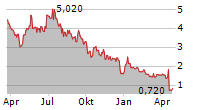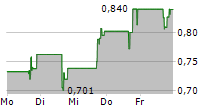
A Dose-Dependent Response in Body Weight Reduction Was Observed Between 8 mg and 32 mg Doses
Change in BMI and Body Weight Adjusted for Height In the Treatment Groups, Showed a Significant Difference Compared to Placebo, Indicating Potentially Greater Efficacy with Increasing Dosage and Longer Duration of Use
No Drug-Induced Cardiovascular Effects Were Observed In Heart Rate or QTcF Measurements of Subjects Receiving up to 32 mg of DA-1726 at 4-Weeks
Additional Cohorts Being Added to Determine Maximum Tolerated Dose
CAMBRIDGE, Mass., April 22, 2025 /PRNewswire/ -- MetaVia Inc. (Nasdaq: MTVA), a clinical-stage biotechnology company focused on transforming cardiometabolic diseases, today reported additional top-line results from the multiple ascending dose (MAD) Part 2 of its Phase 1 clinical trial of DA-1726, a novel, dual oxyntomodulin (OXM) analog agonist that functions as a glucagon-like peptide-1 receptor (GLP1R) and glucagon receptor (GCGR), further demonstrating its potential as a best-in-class obesity drug.
In the 28-day, 36-subject MAD portion of the study, a clear dose-responsive trend in body weight (BW) reduction was observed across the 8 mg to 32 mg range, indicating potentially greater efficacy at higher doses and longer duration of use. Additionally, body mass index (BMI), which shows body weight adjusted for height, showed a difference between the treatment group and the placebo (PBO) group, which was even more pronounced, further supporting the dose-dependent effect of the drug on weight-related outcomes. Of note, DA-1726 did not show any clinically significant increases in heart rate (HR) or QTcF changes up to 32 mg at 4 weeks of administration.
As previously reported, with no titration, DA-1726, with its novel 3:1 ratio between GLP-1R and GCGR at the 32 mg dose, demonstrated compelling maximum weight loss of -6.3% and mean weight loss of -4.3% at Day 26 (p=0.0005), while showing a strong signal of GLP-1R efficacy with maximum lowering of fasted glucose of -18 mg/dL and mean lowering of -5.3 mg/dL at Day 26, and maximum waist circumference reduction of 3.9 inches and mean reduction of 1.6 inches, indicating a strong signal of glucagon efficacy at Day 33.
"This new, additional Phase 1 MAD data further highlights DA-1726's potential to be a best-in-class obesity treatment, showing impressive weight loss results, particularly in terms of BMI reduction," stated Hyung Heon Kim, President and Chief Executive Officer of MetaVia. "Specifically, there was a clear dose-dependent effect on body weight loss between 8 mg and 32 mg, with higher doses leading to greater weight reduction. BMI change from baseline showed the difference between the drug group and the placebo group was even more noticeable. Based on the robust safety and tolerability profile of DA-1726, we believe that 32 mg will likely be the starting dose for future clinical trials."
Mr. Kim continued, "Additionally, activation of either the GLP-1 or glucagon receptors is known to increase heart rate. As a result, dual agonists that simultaneously activate both receptors may raise concerns about excessive heart rate elevation and potential QT interval prolongation. For example, at least one similar dual agonist in clinical trials was discontinued due to an increase in heart rate and other safety concerns. In contrast, the mean heart rate of subjects on DA-1726 showed a slight decrease from baseline in all treatment groups other than the 16 mg cohort where the baseline was significantly lower than other cohorts; the mean decrease after 4 weeks was -14 to -0.7 beats per min (bpm) in the DA-1726 cohorts (4, 8 or 32 mg once weekly) while there was an increase of 7.7 bpm for DA-1726 16 mg cohort. There were no onsets reported in the QTcF (QT interval corrected for heart rate using the method of Fridericia) interval categories>480-500 msec or>500 msec and no risk of cardiovascular events was identified."
Heart Rate (bpm) | Baseline N | Baseline | Day 8 | Day 15 | Day 22 | Day 29 | Mean HR change |
4 mg | 6 | 82.8 | -15.7 | -17.2 | -9.7 | -13.2 | -14.0 |
8 mg | 6 | 77.7 | -4.0 | -6.0 | -5.4 | -6.0 | -5.4 |
16 mg | 6 | 58.8 | 6.0 | 9.5 | 7.7 | 7.5 | 7.7 |
32 mg | 6 | 70.7 | 0.2 | -3.5 | 1.7 | -1.3 | -0.7 |
Pooled Placebo | 12 | 67.6 | -3.0 | -4.0 | -4.4 | 0.7 | -2.7 |
Management also noted that DA-1726's 3:1 balanced activation of GLP-1 and glucagon receptors offers a promising alternative to current GLP-1 agonists, addressing the significant tolerability challenges that lead to 20-30% discontinuation within the first month and up to 70% within a year. As previously reported, a Phase 1 Part 3 study is planned to evaluate DA-1726 patients who discontinued Wegovy® early, aiming to demonstrate improved tolerability, safety, and weight loss outcomes. Additionally, higher-dose cohorts will be included to assess the maximum tolerated dose and fully realize DA-1726's potential as higher doses may also show a similar profile, while potentially demonstrating increased weight reduction.
The Phase 1 trial was a randomized, double-blind, placebo-controlled study to investigate the safety, tolerability, pharmacokinetics (PK), and pharmacodynamics (PD) of single and multiple ascending doses of DA-1726 in obese, otherwise healthy subjects. The MAD portion of the study enrolled healthy adults with a minimum body mass index between BMI 30 - 45 kg/m2. The primary endpoint of the Phase 1 trial was to assess the safety and tolerability of DA-1726 by monitoring adverse events (AEs), serious adverse events (SAEs), treatment emergent adverse events (TEAEs) and AEs leading to treatment discontinuation. Secondary endpoints included the PK of DA-1726, assessed via serum concentrations over time and metabolite profiling at the highest doses of DA-1726. Exploratory endpoints included the effect of DA-1726 on metabolic parameters, cardiac parameters, fasting lipid levels, body weight, waist circumference and body mass index (BMI), among others.
As previously disclosed, in the 28-day, 36-subject MAD portion of the study, DA-1726 demonstrated excellent safety and tolerability, with positive clinical activity. Four out of six subjects on the 32 mg dose experienced mild gastrointestinal (GI) AEs after the first 32 mg dose, most of which were resolved after 24 hours of occurrence. There were no treatment-related discontinuations or SAEs. Early satiety was observed in 83% of subjects receiving the 32 mg dose, suggesting the potential for greater weight loss with longer treatment duration.
Mr. Kim concluded, "After our initial top-line data was announced pre-market on April 15, 2025, the Company's previously issued and outstanding pre-funded warrants were exercised for 1,430,000 shares of the Company's common stock -- leaving no pre-funded warrants outstanding. We continue to believe that the body of data for DA-1726 provides a compelling case for its future potential as a treatment for obesity."
For more information on this clinical trial, please visit: www.clinicaltrials.gov NCT06252220.
About DA-1726
DA-1726 is a novel oxyntomodulin (OXM) analogue functioning as a GLP1R/GCGR dual agonist for the treatment of obesity and Metabolic Dysfunction-Associated Steatohepatitis (MASH) that is to be administered once weekly subcutaneously. DA-1726 acts as a dual agonist of GLP-1 receptors (GLP1R) and glucagon receptors (GCGR), leading to weight loss through reduced appetite and increased energy expenditure. DA-1726 has a well understood mechanism and, in pre-clinical mice models, resulted in improved weight loss compared to semaglutide (Wegovy®) and cotadutide (another OXM analogue). Additionally, in pre-clinical mouse models, DA-1726 elicited similar weight reduction, while consuming more food, compared tirzepatide (Zepbound®) and survodutide (a drug with the same MOA), while also preserving lean body mass and demonstrating improved lipid-lowering effects compared to survodutide.
About MetaVia
MetaVia Inc. is a clinical-stage biotechnology company focused on transforming cardiometabolic diseases. The company is currently developing DA-1726 for the treatment of obesity and is developing DA-1241 for the treatment of Metabolic Dysfunction-Associated Steatohepatitis (MASH). DA-1726 is a novel oxyntomodulin (OXM) analogue that functions as a glucagon-like peptide-1 receptor (GLP1R) and glucagon receptor (GCGR) dual agonist. OXM is a naturally-occurring gut hormone that activates GLP1R and GCGR, thereby decreasing food intake while increasing energy expenditure, thus potentially resulting in superior body weight loss compared to selective GLP1R agonists. DA-1241 is a novel G-protein-coupled receptor 119 (GPR119) agonist that promotes the release of key gut peptides GLP-1, GIP, and PYY. In pre-clinical studies, DA-1241 demonstrated a positive effect on liver inflammation, lipid metabolism, weight loss, and glucose metabolism, reducing hepatic steatosis, hepatic inflammation, and liver fibrosis, while also improving glucose control. In a Phase 2a clinical study, DA-1241 demonstrated direct hepatic action in addition to its glucose lowering effects.
For more information, please visit www.metaviatx.com.
Forward Looking Statements
Certain statements in this press release may be considered forward-looking statements within the meaning of the Private Securities Litigation Reform Act of 1995. Words such as "believes", "expects", "anticipates", "may", "will", "should", "seeks", "approximately", "potential", "intends", "projects", "plans", "estimates" or the negative of these words or other comparable terminology (as well as other words or expressions referencing future events, conditions or circumstances) are intended to identify forward-looking statements. Forward-looking statements are predictions, projections and other statements about future events that are based on current expectations and assumptions and, as a result, are subject to risks and uncertainties. Many factors could cause actual future events to differ materially from the forward-looking statements in this press release, including, without limitation, those risks associated with MetaVia's ability to execute on its commercial strategy; our expectations regarding the sufficiency of our existing cash on hand to fund our operations; the timeline for regulatory submissions; the ability to obtain regulatory approval through the development steps of MetaVia's current and future product candidates; the ability to realize the benefits of the license agreement with Dong-A ST Co. Ltd., including the impact on future financial and operating results of MetaVia; the cooperation of MetaVia's contract manufacturers, clinical study partners and others involved in the development of MetaVia's current and future product candidates; potential negative interactions between MetaVia's product candidates and any other products with which they are combined for treatment; MetaVia's ability to initiate and complete clinical trials on a timely basis; MetaVia's ability to recruit subjects for its clinical trials; whether MetaVia receives results from MetaVia's clinical trials that are consistent with the results of pre-clinical and previous clinical trials; impact of costs related to the license agreement, known and unknown, including costs of any litigation or regulatory actions relating to the license agreement; the effects of changes in applicable laws or regulations; the effects of changes to MetaVia's stock price on the terms of the license agreement and any future fundraising; and other risks and uncertainties described in MetaVia's filings with the Securities and Exchange Commission, including MetaVia's most recent Annual Report on Form 10-K. Forward-looking statements speak only as of the date when made. MetaVia does not assume any obligation to publicly update or revise any forward-looking statements, whether as a result of new information, future events or otherwise, except as required by law.
Contacts:
MetaVia
Marshall H. Woodworth
Chief Financial Officer
+1-857-299-1033
[email protected]
Rx Communications Group
Michael Miller
+1-917-633-6086
[email protected]
SOURCE MetaVia Inc.



